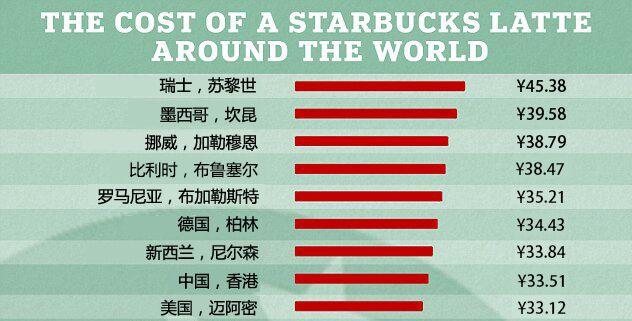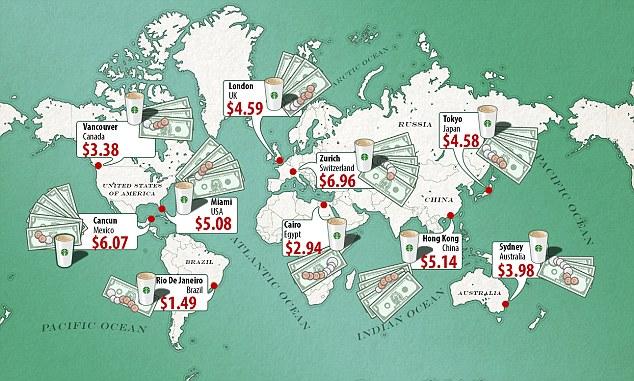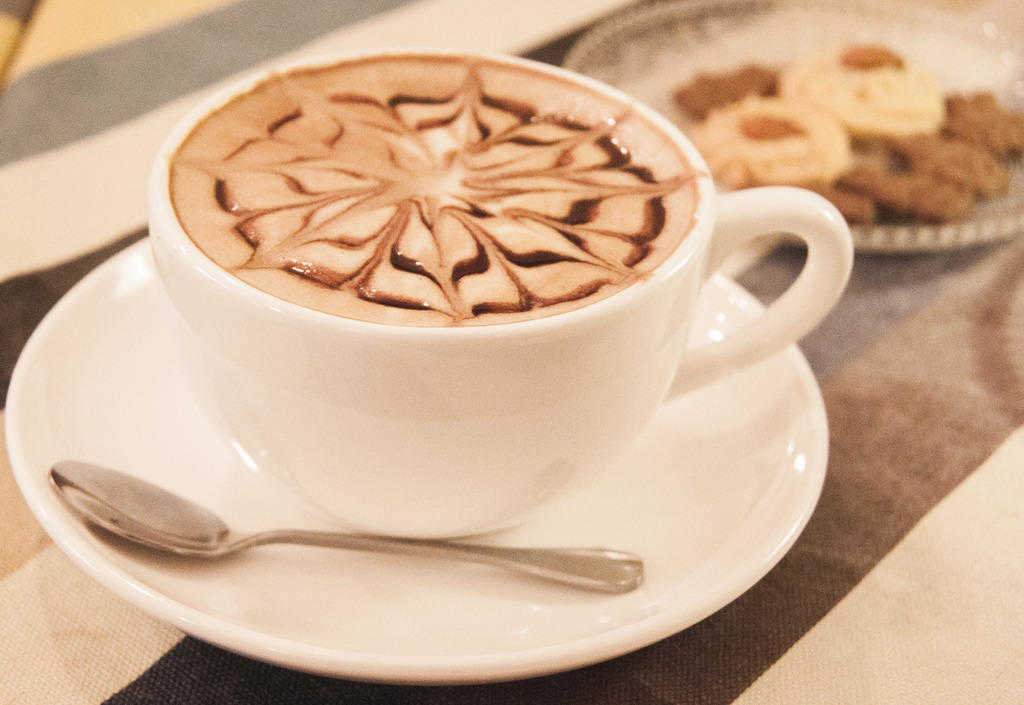Which country is Starbucks from?
Follow the caf é (Wechat official account vdailycom) and found that Beautiful Cafe opened a small shop of its own.
Starbucks (Starbucks) is the name of an American coffee chain, founded in 1971, is the world's largest coffee chain, its headquarters is located in Seattle, Washington, USA.
Is your Starbucks really worth that price? The serious Englishman did collect a price list. As the hometown of Starbucks, the United States is not the most cost-effective place to drink star dads.

Starbucks is the most expensive in the Swiss capital Zurich, with an ordinary latte as high as 45.38 yuan. Cancun, the capital of Mexico, is not far behind, with nearly 40 yuan for a cup of coffee. And the European country Starbucks is also generally more expensive than the European local coffee brands, the price is about 35 yuan. Starbucks in the American coastal city of Miami is also expensive, ranking ninth in the world. By comparison, Starbucks prices in China suddenly seem acceptable.

World Starbucks Price Map
Starbucks gets its name from star buck, a coffee-drinking first mate in Melville's novel Moby Dick. From the beginning of naming, Starbucks has focused on creating its own image of petty bourgeoisie. Melville has a high position in the history of American literature, but not many people read him, basically well-educated and high-quality people. Starbucks wants to release the flavor of quality from the beginning of its name.
Since creating a yuppie atmosphere, niche music is essential. Starbucks has been closely related to music since it acquired record retailer Hear Music in 1999. In 2004, it also released a satellite radio station that played jazz, blues and rock music. Starbucks listening to Music has become popular abroad but is rarely seen at home due to legal restrictions. Starbucks music is not designed to boost coffee sales, but to make people find music they can't hear elsewhere, providing a unique Starbucks experience. Starbucks has strict requirements on the quality of all the basic coffee. In order to achieve the good taste of coffee, it has spent a lot of energy on the training of front-line employees. Employees are required to grasp the time and heat of brewing coffee without the aid of auxiliary tools, and employees are encouraged to pour out coffee that does not meet the quality requirements of Starbucks. The equipment and materials for coffee production are all shipped from the head office.
Starbucks also pays great attention to its own style in design. Starbucks has its own design team, and each new store will send local photos first. The design team combines Starbucks style and local environment to design a storefront with clear recognition and harmony with the local environment. In the packaging design of various products, Starbucks also pays attention to detail, each product has its own different packaging and unique design, Starbucks occasional mugs have become the object of many people's collection. Starbucks starts from every detail, in order to give customers a high-quality experience to create a "coffee religion" characterized by "Starbucks experience".
After completing the self-positioning, it is necessary to show the charm of the brand to the majority of consumers, which is also an important step in building a corporate image.
Starbucks has taken a unique path in brand communication. In the modern society with developed mass media, Starbucks consciously does not rely on huge advertising spending but relies on the old and direct method of word-of-mouth. Although simple but not low-key, Starbucks' global success is a powerful illustration of the effectiveness of this mode of communication. 'our storefront is the best advertising, 'Mr. Schultz said.' like Procter & Gamble, it was impossible to build a brand with huge ads from the beginning, 'Mr. Schultz said.' we can only start with our own stores one customer at a time and accumulate slowly. Starbucks stores are surrounded in the bustling area of Beijing, Wangfujing, Shanghai, Xintiandi, Qingdao's Hong Kong East Road, the design of the store and the service in the store all visually reflect the cultural charm of Starbucks. Starbucks believes that in the service industry, the most important marketing channel is the branch itself, not advertising. If the products and services in the store are not good enough, no matter how many advertisements are made to attract customers, they will only see a negative image. They say Starbucks is not willing to spend a lot of money on advertising and promotion, but insists that every employee has the most professional knowledge and service enthusiasm. "our employees, like coffee fans, can explain the characteristics of each coffee product to customers in detail. Only through an one-on-one way to win trust and word of mouth. This is both economical and affordable, and it is also the uniqueness of Starbucks! "
85% of Starbucks' revenue comes from face-to-face contact with consumers, and every interaction between employees and consumers is the biggest determinant of brand impression, so Starbucks attaches great importance to the training of employees, cares about the interests of employees, and carries out popular marketing. At Starbucks, employees get a lot of training, including coffee, interpersonal communication, leadership and so on. Moreover, Starbucks gives all employees a wide range of medical insurance and stock options, giving every employee, even part-time employees, the opportunity to participate in the company's shares in the form of bean stock, which greatly enhances employees' sense of belonging and sense of ownership and motivates their work. Starbucks has the lowest employee turnover in its kind of industry, and many college students are proud of working at Starbucks. Loyal employees have become the main driving force for providing consumers with the "Starbucks experience" and the main source of "word of mouth". It is Starbucks' marketing principle that conquers its own employees in order to conquer consumers and then conquer the whole world.
There is no doubt that the favor of some literary novelists has also promoted the promotion of Starbucks. In some novels, there are often scenes of "Starbucks afternoon" or handsome young company leaders sitting in Starbucks with a tuna burger and a cup of coffee after work. Starbucks consumers are already focused on young people in their twenties, and novels, as an important way of leisure for this group, have a great influence. This is the celebrity communication effect extended by Schultz's word-of-mouth strategy, not to pay for endorsements, but celebrities to spontaneously promote Starbucks with their own actions.
In terms of crisis management, Starbucks attaches importance to but moderate, and adopts a low-key and multi-processing approach to get through the crisis smoothly. 2007 can be said to be an eventful year for Starbucks, from the smoke-filled "trans fat gate" incident, to the "Imperial Palace incident" with the color of cultural aggression, to the sudden "milk exchange incident". One crisis after another left Starbucks in the mud. Today, when we look back on Starbucks' behavior in this series of events, we can see the wisdom of an international brand in crisis management-keeping a low profile, but not inaction. We can all understand such a truth: doing nothing and hoping that it will be forgotten will only make things worse, make the crisis vivid and interesting, and instead attract more people's attention. only in low-key crisis management, there is no lack of frankness and integrity to maintain public respect and prevent the situation from deteriorating.
Taking the "Forbidden City incident" as an example, on January 12, CCTV English anchor Rui Chenggang issued a public protest to Starbucks on his blog entitled "Please Starbucks out of the Forbidden City." the article said that Starbucks in the Forbidden City is not globalization, but the erosion of Chinese culture. With the continuous expansion of the scope of spread, this incident was put on the high hat of "cultural aggression", and Starbucks was also pushed to the forefront of the wind and waves. Subsequently, Jim Donnaud, global president and CEO of Starbucks, wrote to Rui Chenggang, "We are
This branch is opened with respect for and high sensitivity to the cultural and historical traditions of the Forbidden City. We have been and will continue to express our respect for local history, culture and social customs. " Unlike the usual practice of other brands in crisis management-- the press spokesman responded to questions-- the president's reply fully demonstrated Starbucks' public relations wisdom and its humane corporate culture. Soon, the focus turned to the Palace Museum, where Starbucks weathered the crisis quietly.
Starbucks brand image reflects his innovation and creativity, with unique cultural charm, experiential service concept, through word of mouth, let this green mermaid swim from Seattle to the world. Starbucks coffee culture has gradually swept the markets of four continents and become the fastest growing enterprise. From the perspective of Starbucks' road to success, for the building of a corporate brand image, a simple public relations building through inherent routines cannot promote a charming enterprise. A truly successful brand maker should pay love and emotion to his own brand and create his own corporate culture. While absorbing experience, we should also pay attention to innovation and development, combining the times with the market and combining the hearts of the people. Follow your own path of development.
Important Notice :
前街咖啡 FrontStreet Coffee has moved to new addredd:
FrontStreet Coffee Address: 315,Donghua East Road,GuangZhou
Tel:020 38364473
- Prev

Starbucks caramel macchiato sweet? caramel macchiato coffee and the correct way to drink
Follow the caf é (Wechat official account vdailycom) found that Starbucks caramel macchiato sweet hot ice is good, but do not order ice and de-ice, this deicing is very disgusting, not only no level of beauty, caramel sauce will float on it like a slug.
- Next

Starbucks preferred source of coffee beans
Following Cafe Review (Wechat official account vdailycom) found that Fairview Cafe opened a small shop of its own. Where do Starbucks produce coffee beans? Starbucks coffee is purchased globally, they only purchase beans from high-quality areas around the world, which are then deeply roasted and freshly used. However, Starbucks sells different coffee beans in different countries, and the United States has the largest variety of coffee beans.
Related
- Detailed explanation of Jadeite planting Land in Panamanian Jadeite Manor introduction to the grading system of Jadeite competitive bidding, Red bid, Green bid and Rose Summer
- Story of Coffee planting in Brenka region of Costa Rica Stonehenge Manor anaerobic heavy honey treatment of flavor mouth
- What's on the barrel of Blue Mountain Coffee beans?
- Can American coffee also pull flowers? How to use hot American style to pull out a good-looking pattern?
- Can you make a cold extract with coffee beans? What is the right proportion for cold-extracted coffee formula?
- Indonesian PWN Gold Mandrine Coffee Origin Features Flavor How to Chong? Mandolin coffee is American.
- A brief introduction to the flavor characteristics of Brazilian yellow bourbon coffee beans
- What is the effect of different water quality on the flavor of cold-extracted coffee? What kind of water is best for brewing coffee?
- Why do you think of Rose Summer whenever you mention Panamanian coffee?
- Introduction to the characteristics of authentic blue mountain coffee bean producing areas? What is the CIB Coffee Authority in Jamaica?

